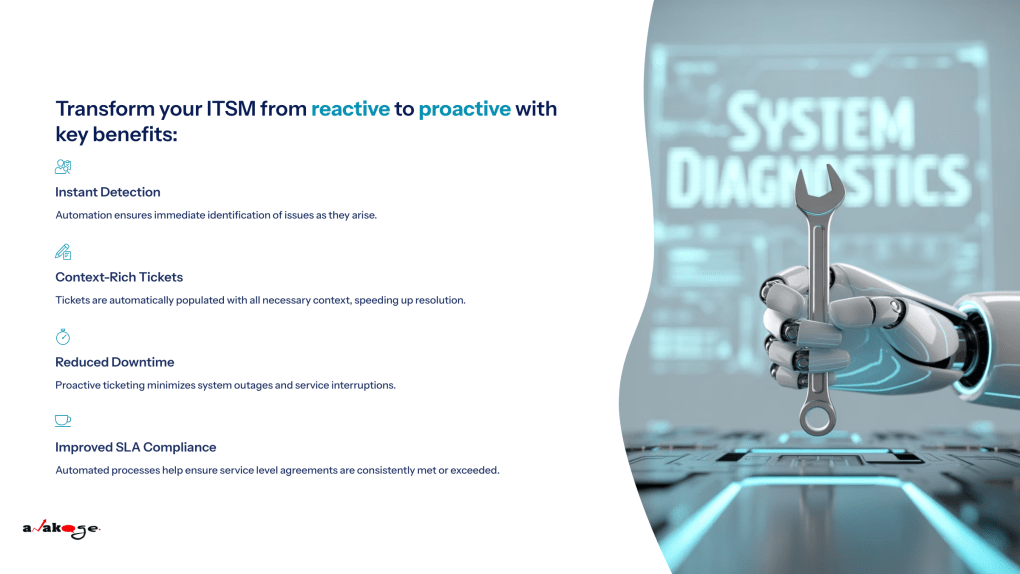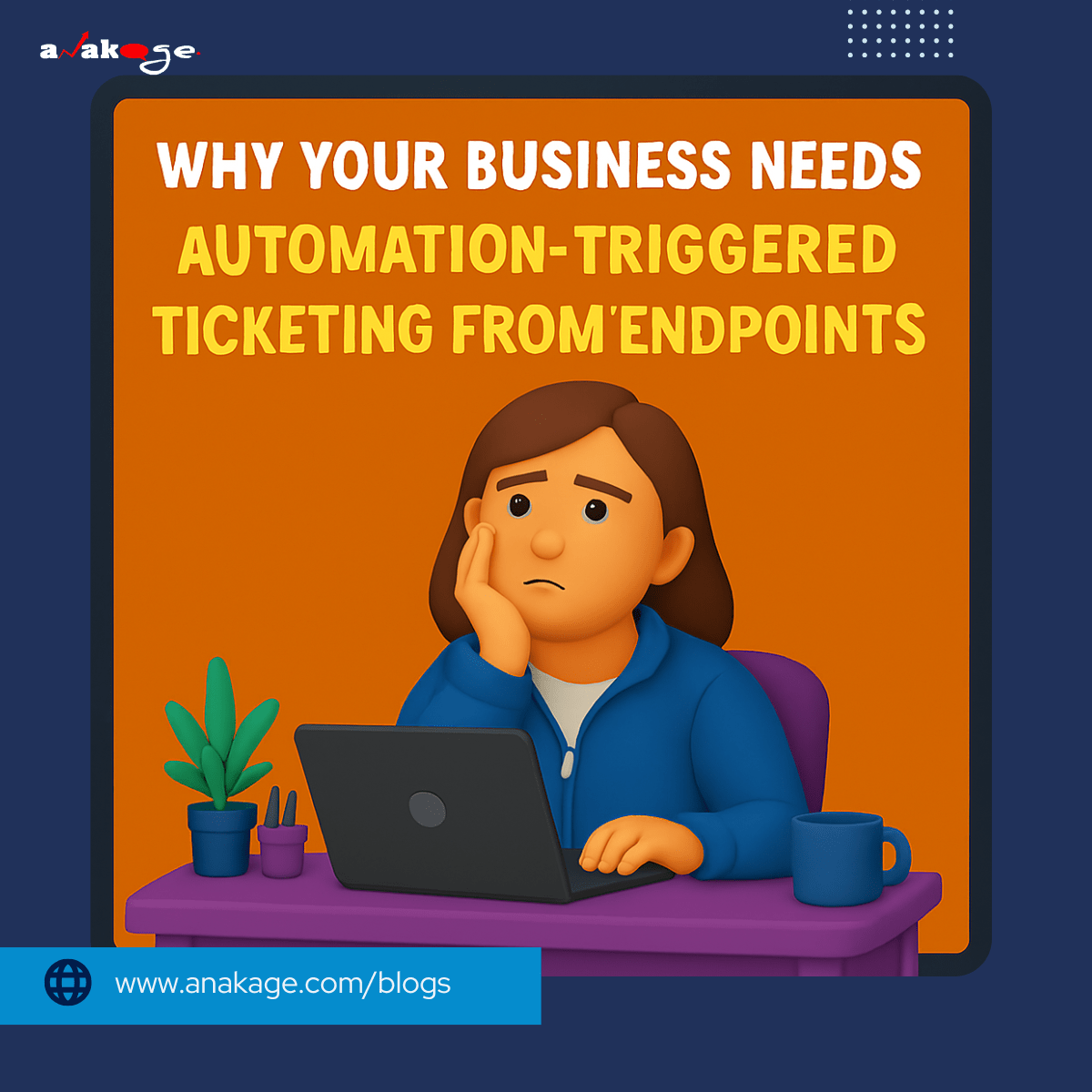Contents
- 1 Why Your Business Needs Automation-Triggered Ticketing from Endpoints
- 1.1 Direct Answer First
- 1.2 The Business Challenge with Manual Ticketing
- 1.3 What is Automation-Triggered Ticketing from Endpoints?
- 1.4 How Automation-Triggered Ticketing Works
- 1.5 Real-World Scenarios Where This Adds Value
- 1.6 Business Benefits of Automation-Triggered Ticketing
- 1.7 Implementation Best Practices
- 1.8 How Anakage Enables Automation-Triggered Ticketing
- 1.9 Conclusion: Connecting Back to Intelligent ITSM
Why Your Business Needs Automation-Triggered Ticketing from Endpoints
Direct Answer First

Automation-triggered ticketing from endpoints ensures IT issues are detected and logged instantly—without waiting for employees to report them. By automatically converting anomalies like failed patches or storage alerts into tickets, IT teams gain real-time visibility, reduce downtime, and maintain SLA compliance, making ITSM more proactive, efficient, and employee-centric.
The Business Challenge with Manual Ticketing
In most organizations, IT incidents are still reported the old-fashioned way: employees raise a ticket only after they experience a disruption. While simple in theory, this model introduces significant business risks.
- Delayed detection: A disk nearing failure or antivirus turning inactive may go unnoticed for hours or days until it impacts productivity.
- Incomplete information: Manual tickets rarely include device-level context. IT staff must spend additional time running diagnostics before resolving the issue.
- Increased downtime: By the time IT gets visibility, the incident has often escalated, SLA deadlines are looming, and employees are already frustrated.
For businesses navigating hybrid work, distributed teams, and high expectations for uninterrupted digital services, this reactive model is inadequate. Enterprises require ITSM systems that detect issues at the source and create tickets automatically—long before end-users raise alarms.
What is Automation-Triggered Ticketing from Endpoints?
Automation-triggered ticketing is the process of converting endpoint anomalies directly into ITSM tickets, without human intervention. Endpoints—laptops, desktops, servers, and other devices—continuously generate health signals. These can include system crashes, CPU stress, patching failures, or security gaps. Instead of relying on employees to report them or external tools to pick them up, the ITSM platform itself creates and routes tickets in real time.
This approach provides IT teams with:
- Continuous monitoring: Issues are detected even outside business hours.
- Context-rich tickets: Hardware/software metadata is included automatically.
- Seamless escalation: Incidents are prioritized and routed based on predefined rules.
In today’s complex enterprise IT landscape, this shift from reactive to proactive ticketing is critical for operational resilience and employee satisfaction.
How Automation-Triggered Ticketing Works
At a practical level, automation-triggered ticketing integrates three building blocks: detection, ticket generation, and routing. Anakage’s ITSM modules streamline this into a single automated flow:
- Endpoint Anomaly Detection
Lightweight monitoring identifies events like antivirus deactivation, low disk space, failed patching, or recurring BSOD (Blue Screen of Death) errors. - Automated Ticket Creation
Detected anomalies instantly generate tickets enriched with system context—CPU usage, OS version, last patch attempt, etc.—reducing the need for manual triage. - Intelligent Routing and SLA Alignment
Rules define where tickets go: desktop support, security team, or application specialists. SLAs and escalation workflows apply automatically, keeping incidents aligned with business priorities. - Visibility and Communication
IT staff and employees are notified, with real-time dashboards offering live updates instead of static Excel exports.
By embedding automation directly at the endpoint level, ITSM shifts into a proactive, self-driven model where problems are captured and queued before they escalate.
Real-World Scenarios Where This Adds Value
To illustrate its importance, consider common IT scenarios:
- Failed Software Deployment
An automation deploys new software across 100 endpoints. On 5 machines, the installation fails. Instead of waiting for users to complain, tickets are generated instantly with logs attached for IT review. - Disk Capacity Breach
An employee’s laptop reaches 90% disk usage. An alert is raised, and a ticket is automatically created, preventing the crash that would otherwise halt work. - Patch Compliance Failure
A device misses a scheduled security patch. The system generates a ticket with error codes, allowing IT to remediate before compliance auditors flag the issue. - Inactive Antivirus
When AV protection is disabled, tickets are created in real time. This rapid detection limits exposure windows and helps IT maintain endpoint security posture.
In all these scenarios, automation ensures IT gets early visibility, saving time and reducing productivity losses.
Business Benefits of Automation-Triggered Ticketing
- Faster Incident Resolution (MTTR)
With issues logged immediately and routed intelligently, IT teams resolve problems before they impact operations. - Improved SLA Performance
By removing delays in detection and logging, SLA adherence becomes significantly easier. Escalations are tied to predefined thresholds, ensuring accountability. - Reduced IT Workload
Automation eliminates repetitive manual triaging. IT staff spend more time on complex problem-solving rather than data entry. - Enhanced Employee Experience
Employees encounter fewer disruptions since many issues are detected and resolved without their involvement. This directly improves DEX (Digital Employee Experience). - Strengthened Compliance and Governance
Every anomaly and response action is automatically logged, ensuring transparency for audits and regulatory checks.
These benefits collectively move ITSM away from firefighting and toward being a true enabler of business continuity.
Implementation Best Practices
Organizations considering automation-triggered ticketing should follow a few best practices to maximize its value:
- Define Clear Anomaly Thresholds
Set specific triggers for disk usage, CPU stress, patch failures, and security events. Avoid over-alerting to keep ticket queues manageable. - Customize Routing Rules
Align ticket routing with internal support structures—desktop, server, application, or security teams. - Integrate with SLAs and XLAs
Ensure auto-created tickets link directly to SLA timers and escalation policies. Where possible, include XLAs (Experience Level Agreements) to measure employee satisfaction alongside resolution times. - Use Real-Time Dashboards
Replace static reports with dashboards that refresh automatically, giving IT leadership live insights into ticket volumes and SLA health. - Pilot Before Scaling
Start with a controlled rollout—such as patch compliance tickets—before expanding across all endpoint anomalies. This helps teams adjust processes gradually.
How Anakage Enables Automation-Triggered Ticketing
Anakage’s ITSM platform includes built-in capabilities that make automation-triggered ticketing seamless:
- Agent-Based Anomaly Detection: Lightweight agents detect endpoint health issues in real time.
- Context-Rich Ticket Generation: Tickets include device health, software status, and event logs.
- Smart Routing: Incidents are directed to the correct support tier or department.
- Integrated Dashboards: Live visibility into tickets, SLAs, and compliance metrics without third-party BI tools.
- Cross-Module Synergy: Endpoint monitoring, Asset Management, Patch Management, and ITSM modules work together, ensuring accurate data and consistent remediation.
This creates an integrated ecosystem where incidents move seamlessly from detection to resolution without manual intervention.
Conclusion: Connecting Back to Intelligent ITSM
Automation-triggered ticketing from endpoints represents a major step forward in modern IT service management. By shifting from user-reported incidents to system-detected events, IT teams gain faster visibility, protect SLAs, and deliver a smoother digital experience for employees.
This capability aligns directly with the broader vision of lightweight and intelligent ITSM: systems that are proactive, context-aware, and designed to minimize disruption.
To explore how endpoint intelligence, guided automation, and AI-driven workflows combine into a practical ITSM framework, read our pillar page: [A Practical Guide to Lightweight & Intelligent IT Service Management].
Next Step:
[Schedule a Personalized Demo Today]
Have you read about our last release? Click here to read!

